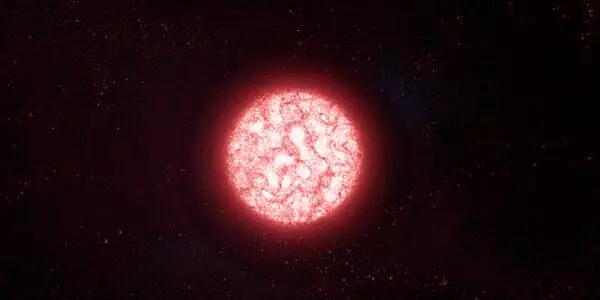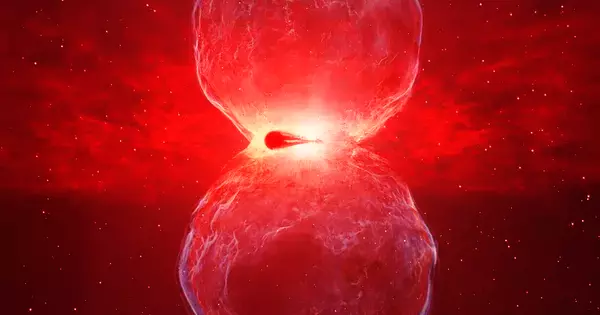A research team has discovered the fastest nova ever observed. They hope to discover answers not only to the nova’s many perplexing characteristics, but also to larger questions about our solar system and the universe. Astronomers are buzzing after witnessing the world’s fastest nova. The unusual occurrence drew the attention of scientists to an even more unusual star. They may discover answers not only to the nova’s many puzzling characteristics, but also to larger questions about the chemistry of our solar system, the death of stars, and the evolution of the universe as they study it.
The research team, led by Arizona State University Regents Professor Sumner Starrfield, Professor Charles Woodward from the University of Minnesota, and Research Scientist Mark Wagner from The Ohio State University, co-authored a report published today in the American Astronomical Society’s Research Notes.
A nova is a sudden explosion of bright light from a two-star system. Every nova is caused by a white dwarf (the very dense leftover core of a star) and a nearby companion star. Over time, the white dwarf draws matter from its companion, which falls onto the white dwarf. The white dwarf heats this material, causing an uncontrolled reaction that releases a burst of energy. The explosion accelerates the matter, which we see as visible light.
The bright nova usually fades after a few weeks or more. The nova V1674 Hercules burst so brightly that it was visible to the naked eye on June 12, 2021, but it faded away in less than a day. It was like someone turned on and off a flashlight.
We’re always trying to figure out how the solar system formed and where the chemical elements in the solar system came from. One of the things we’ll learn from this nova is how much lithium was produced as a result of the explosion.
Professor Sumner Starrfield
Nova events at this speed are uncommon, making this nova an invaluable research subject.
“It was only about one day,” says Starrfield, an astrophysicist at ASU’s School of Earth and Space Exploration. “The previous fastest nova we studied back in 1991, V838 Herculis, which declined in about two or three days.”
As the astronomy world watched V1674 Hercules, other researchers found that its speed wasn’t its only unusual trait. The light and energy it sends out is also pulsing like the sound of a reverberating bell.
Every 501 seconds, there is a wobble visible in both visible light waves and X-rays. The nova is still wobbly a year after it exploded, and it appears to have been going on for even longer. Starrfield and his colleagues have continued to investigate this anomaly.
“The most unusual thing about this oscillation is that it was visible before the outburst, but it was also visible when the nova was about 10 magnitudes brighter,” says Wagner, who is also the head of science at the Large Binocular Telescope Observatory, which was used to observe the nova. “A mystery that people are attempting to solve is what is driving this periodicity that you would see in the system over that range of brightness.”
The team also noticed something strange while monitoring the matter ejected by the nova explosion: some kind of wind, which may be dependent on the positions of the white dwarf and its companion star, is shaping the flow of material into space surrounding the system. Though the fastest nova is (literally) flashy, it is worth further investigation because novae can reveal important information about our solar system and even the universe as a whole.

During a nova explosion, a white dwarf collects and modifies matter, then seasons the surrounding space with new material. It’s an important part of the matter cycle in space. The materials ejected by novae will eventually form new stellar systems. Such events helped form our solar system as well, ensuring that Earth is more than a lump of carbon.
“We’re always trying to figure out how the solar system formed and where the chemical elements in the solar system came from,” says Starrfield. “One of the things we’ll learn from this nova is how much lithium was produced as a result of the explosion. We can now say with certainty that these types of explosions produced a significant portion of the lithium on Earth.”
Because a white dwarf star does not always lose all of its collected matter during a nova explosion, it gains mass with each cycle. This would eventually cause it to become unstable, and the white dwarf could explode into a type 1a supernova, one of the brightest events in the universe. Each type 1a supernova reaches the same level of brightness, so they are known as standard candles.
“Standard candles are so bright that we can see them at great distances across the universe. By looking at how the brightness of light changes, we can ask questions about how the universe is accelerating or about the overall three-dimensional structure of the universe,” Woodward says. “This is one of the interesting reasons that we study some of these systems.”
Additionally, novae can tell us more about how stars in binary systems evolve to their death, a process that is not well understood. They also act as living laboratories where scientists can see nuclear physics in action and test theoretical concepts.
The nova caught astronomers off guard. It was unknown to scientists until Seidji Ueda, a Japanese amateur astronomer, discovered and reported it. Citizen scientists, like modern technology, are becoming increasingly important in the field of astronomy. Even though the nova is now too faint for other types of telescopes to see, the team can still monitor it thanks to the Large Binocular Telescope’s wide aperture and the observatory’s other equipment, which includes a pair of multi-object double spectrographs and the exceptional PEPSI high resolution spectrograph.
They intend to look into the cause of the outburst and the processes that led to it, as well as the reason for its record-breaking decline, the forces driving the observed wind, and the source of its pulsing brightness.





